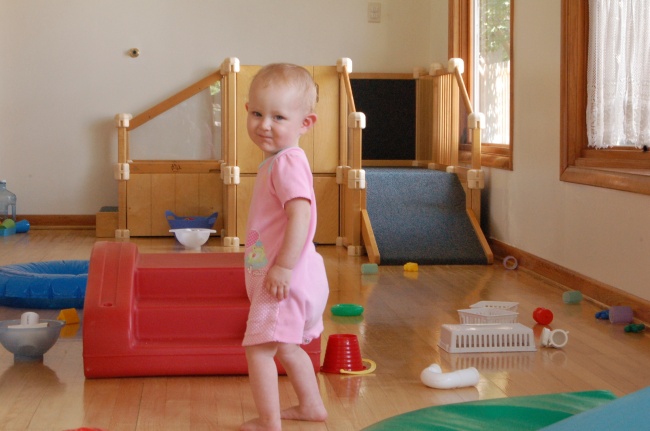Reprinted with permission from TOILET TRAINING, by Beverly Kovach, MN, c.1997. Beverly has been working with and consulting in early childhood centers for more than 30 years. She is a RIE Mentor Teacher and was a member of the Board of Directors from 2001 until 2008. Beverly is a Montessori teacher-trainer, consultant, and presenter at national and international conferences, and co-author of Being with Babies. She founded Little Learners Lodge and Montessori of Mt. Pleasant, South Carolina in 1977 and established Waverly Place (the first RIE Satellite Center in the USA) in 2003. Ms. Kovach also serves as a Pikler Teacher Trainer, USA.
How to Approach Your Child for Toilet Training

When you feel your child is ready and have noticed many of the signs, you can begin with toilet learning.
I feel your approach is important to the outcome of the toilet learning. This is a natural process. Toileting is something we do every day in our lives. There is nothing to be ashamed of or inhibited about. It is important to be relaxed and very positive. Before this cild actually sits on the toilet, it is a good idea to begin to prepare the child or ease the child carefully into the idea of using the toilet. For example, you might let him flush the toilet to see the water go down and and then watch as the bowl fills again.
I caution you not to force the child on the toilet. Another way to prepare the child is to let the child put a little toilet paper in the toilet and then flush. Allow the child to watch other children or other family members use the toilet. He or she will get an accurate idea of what is expected that way.
It is helpful to read a book about using the toilet. An exceptionally good one is Toilet Learning: The Picture Book Technique for Children and Parents, by Alison Mach (Little Brown and Company, 1978).
It is also a good idea to introduce pants with an elastic waistband. Show the child how to pull them down and then how to pull the pants up. I would also introduce underpants, not necessarily trying them on unless the child wants to.
Who is ready for toilet training? Here are the signs to look for:
1. a morning dry diaper- nighttime bladder and bowel control
2. dry diaper during the daytime- it is obvious the child’s bladder control is to the point where he or she can retain urine for a period of time (about two hours).
3. bowel movements are somewhat regular in terms of the same time of day
4. bowel movements are formed and have a definite shape
5. the child may tell you, “I have to pee pee,” when, in fact, he or she has already urinated
6. the child may ask to use the toilet
7. the child may tell you he or she needs a diaper change
8. the child may anticipate urinating or defecating then go ahead and do it, showing genuine awareness
9. balance- is the child physically able to sit on the toilet; can he or she get on the toilet independently of the adult
10. undressing- is the child capable of pulling down pants and pulling them back up again
The reality is that once a child decides to use the toilet, he knows how to do it. It is unnecessary to teach, practice, exercise the little techniques. Children do learn to dress and undress themselves if parents encourage cooperation every time they care for them. If each diapering has been a pleasurable experience- a true dialogue between parent and chid- if the caregiver has given her full attention during all these times, there will be no need for the special circus perform and of “The Day” (Magda Gerber, 1979)

Comments